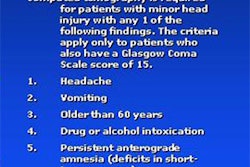Patients with blunt trauma are at a high risk for thoracolumbar spine fractures, which require swift evaluation. Spinal x-ray is commonly used in these situations, but it is a time-consuming and difficult exam. So a group of surgeons and radiologists investigated whether CT might be a viable alternative.
While the researchers determined that CT does offer several advantages over x-ray in these types of injuries, they stopped short of stating that CT could replace plain film as a screening method.
"The ideal tool for screening the spine would be accurate and rapid while avoiding added cost or risk to the patient. This would allow early identification of stable or unstable spine fractures and appropriate management," wrote Dr. Gabriel Berry and colleagues in the Journal of Trauma Injury, Infection and Critical Care (December 2005, Vol. 59:6, pp. 1410-1413).
Berry and several co-authors are from Wake Forest University School of Medicine in Winston-Salem, NC. Co-author Dr. Mitchel Harris is from the department of orthopedic surgery at Brigham and Women's Hospital in Boston.
For this retrospective review, the authors mined two months' worth of data from a trauma database at Wake Forest. Patients were included if they had undergone x-ray of the thoracolumbar spine as well as CT of the chest, abdomen, and pelvis. The authors referred to the latter as CAP CT.
Helical CAP CT was performed using a pitch of 1 with 5-mm reconstruction (Lightspeed, GE Healthcare, Chalfont St. Giles, U.K). The authors did a receiver operator curve (ROC) analysis and calculated for specificity, sensitivity, and positive and negative predictive values (PPV and NPV) of CAP CT and spinal x-ray.
The final data pool consisted of 103 patients, of which 25% (26) were diagnosed with thoracolumbar spine fractures (27 thoracic spine and 28 lumbar spine fractures). All 26 patients had their fractures confirmed on CAP CT. In comparison, x-ray only identified 19 of 26 fractures.
The area under the ROC curve was 0.98 for CAP CT and 0.86 for plain film. Overall, 93% of any type of fracture was seen on CAP CT in comparison to 67% with x-ray.
In terms of sensitivity, CAP CT came in 100%. The specificity was 97%, the NPV was 100%, and the PPV was 100%. For x-ray, the sensitivity was 73%, the specificity was 100%, the NPV was 92%, and the PPV was 100%.
"Although specificity and PPV are better with plain radiographs, this comes with a signification reduction in sensitivity that translates to missed fractures and the potentially devastating neurologic sequelae with which they are associated," the authors wrote.
With regard to dose, CAP CT did deliver three to four times more radiation than anterioposterior and lateral thoracic and lumbar spine films, they pointed out. However, x-ray exams took much longer (median time of two hours, 48 minutes), and multiple sets of films were required at times.
Despite all the pluses of CAP CT, "these data do not suggest that admission CAP CT could be used for definitive anatomic delineation of injury or operative planning," the group cautioned.
CAP CT's greatest flaw is that it cannot identify individual fractures, such as important compression fractures, the researchers explained. In addition, the availability of CT may determine whether it will be of value. Not all institutions have the ability to perform CT image reformatting or reconstructions, they said. Indeed, some smaller hospitals may still be working with older, less sophisticated scanners.
"Thus CT of the (thoracolumbar spine) should not become a standard applied to every trauma patient," they stated. "For the foreseeable future, the initial step in spine management should remain a determination of whether radiologic clearance or clearance by clinical examination is indicated." If imaging is called for, then CT does offer the more sensitive test, they added.
By Shalmali Pal
AuntMinnie.com staff writer
January 30, 2006
Related Reading
CT is the blanket modality for neuroimaging blunt injury patients, January 12, 2006
When x-ray finds cervical spine injuries, CT picks up more, September 14, 2005
Overexposed? CT in the emergency room, October 21, 2004
Copyright © 2006 AuntMinnie.com



















